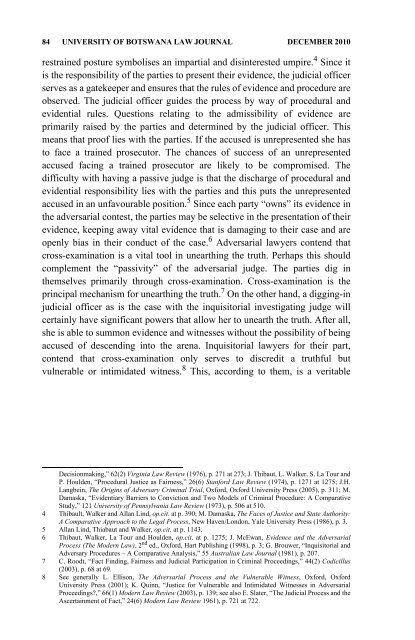University of Botswana Law Journal - PULP
University of Botswana Law Journal - PULP
University of Botswana Law Journal - PULP
Create successful ePaper yourself
Turn your PDF publications into a flip-book with our unique Google optimized e-Paper software.
84 UNIVERSITY OF BOTSWANA LAW JOURNAL DECEMBER 2010<br />
restrained posture symbolises an impartial and disinterested umpire. 4 Since it<br />
is the responsibility <strong>of</strong> the parties to present their evidence, the judicial <strong>of</strong>ficer<br />
serves as a gatekeeper and ensures that the rules <strong>of</strong> evidence and procedure are<br />
observed. The judicial <strong>of</strong>ficer guides the process by way <strong>of</strong> procedural and<br />
evidential rules. Questions relating to the admissibility <strong>of</strong> evidence are<br />
primarily raised by the parties and determined by the judicial <strong>of</strong>ficer. This<br />
means that pro<strong>of</strong> lies with the parties. If the accused is unrepresented she has<br />
to face a trained prosecutor. The chances <strong>of</strong> success <strong>of</strong> an unrepresented<br />
accused facing a trained prosecutor are likely to be compromised. The<br />
difficulty with having a passive judge is that the discharge <strong>of</strong> procedural and<br />
evidential responsibility lies with the parties and this puts the unrepresented<br />
accused in an unfavourable position. 5 Since each party “owns” its evidence in<br />
the adversarial contest, the parties may be selective in the presentation <strong>of</strong> their<br />
evidence, keeping away vital evidence that is damaging to their case and are<br />
openly bias in their conduct <strong>of</strong> the case. 6 Adversarial lawyers contend that<br />
cross-examination is a vital tool in unearthing the truth. Perhaps this should<br />
complement the “passivity” <strong>of</strong> the adversarial judge. The parties dig in<br />
themselves primarily through cross-examination. Cross-examination is the<br />
principal mechanism for unearthing the truth. 7 On the other hand, a digging-in<br />
judicial <strong>of</strong>ficer as is the case with the inquisitorial investigating judge will<br />
certainly have significant powers that allow her to unearth the truth. After all,<br />
she is able to summon evidence and witnesses without the possibility <strong>of</strong> being<br />
accused <strong>of</strong> descending into the arena. Inquisitorial lawyers for their part,<br />
contend that cross-examination only serves to discredit a truthful but<br />
vulnerable or intimidated witness. 8 This, according to them, is a veritable<br />
3 R.M. Hayden and J.K. Anderson, “On The Evaluation <strong>of</strong> Procedural Systems in Laboratory Experiments:<br />
A Critique <strong>of</strong> Thibaut and Walker,” 3 (1/2) <strong>Law</strong> and Human Behaviour (1979), p. 21 at 22; E. Allan Lind,<br />
J. Thibaut and L. Walker, “Discovery and Presentation <strong>of</strong> Evidence in Adversary and Nonadversary<br />
Proceedings,” 71(6) Michigan <strong>Law</strong> Review (1973), p. 1129 at 1143; A.S. Goldstein, “Reflections on Two<br />
Models: Inquisitorial Themes in American Criminal Procedure,” 26(5) Stanford <strong>Law</strong> Review (1974), p.<br />
1009 at 1016; J. Thibault, L. Walker and E. Allan Lind, “Adversary Presentation and Bias in Legal<br />
Decisionmaking,” 86(2) Harvard <strong>Law</strong> Review (1972), p. 386 at 388; A. Lind, J. Thibaut and L. Walker,<br />
“A Cross-Cultural Comparison <strong>of</strong> the Effect <strong>of</strong> Adversary and Inquisitorial Processes on Bias in Legal<br />
Decisionmaking,” 62(2) Virginia <strong>Law</strong> Review (1976), p. 271 at 273; J. Thibaut, L. Walker, S. La Tour and<br />
P. Houlden, “Procedural Justice as Fairness,” 26(6) Stanford <strong>Law</strong> Review (1974), p. 1271 at 1275; J.H.<br />
Langbein, The Origins <strong>of</strong> Adversary Criminal Trial, Oxford, Oxford <strong>University</strong> Press (2005), p. 311; M.<br />
Damaska, “Evidentiary Barriers to Conviction and Two Models <strong>of</strong> Criminal Procedure: A Comparative<br />
Study,” 121 <strong>University</strong> <strong>of</strong> Pennsylvania <strong>Law</strong> Review (1973), p. 506 at 510.<br />
4 Thibault, Walker and Allan Lind, op.cit. at p. 390; M. Damaska, The Faces <strong>of</strong> Justice and State Authority:<br />
A Comparative Approach to the Legal Process, New Haven/London, Yale <strong>University</strong> Press (1986), p. 3.<br />
5 Allan Lind, Thiabaut and Walker, op.cit. at p. 1143.<br />
6 Thibaut, Walker, La Tour and Houlden, op.cit. at p. 1275; J. McEwan, Evidence and the Adversarial<br />
Process (The Modern <strong>Law</strong>), 2 nd ed., Oxford, Hart Publishing (1998), p. 3; G. Brouwer, “Inquisitorial and<br />
Adversary Procedures – A Comparative Analysis,” 55 Australian <strong>Law</strong> <strong>Journal</strong> (1981), p. 207.<br />
7 C. Roodt, “Fact Finding, Fairness and Judicial Participation in Criminal Proceedings,” 44(2) Codicillus<br />
(2003), p. 68 at 69.<br />
8 See generally L. Ellison, The Adversarial Process and the Vulnerable Witness, Oxford, Oxford<br />
<strong>University</strong> Press (2001); K. Quinn, “Justice for Vulnerable and Intimidated Witnesses in Adversarial<br />
Proceedings?,” 66(1) Modern <strong>Law</strong> Review (2003), p. 139; see also E. Slater, “The Judicial Process and the<br />
Ascertainment <strong>of</strong> Fact,” 24(6) Modern <strong>Law</strong> Review 1961), p. 721 at 722.
















